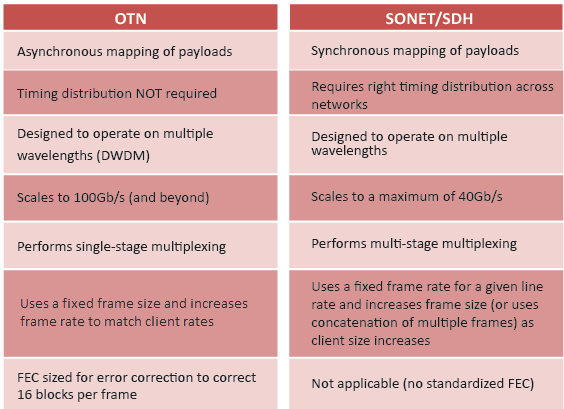
In the Access network, we have heard about ONT. Now, I tell you this OTN. Same letters, different order. Are OTN and ONT the same things?
Obviously not!
ONT belongs to the Access network. It’s the Optical network terminal, a product in the xPON network access solution.
However, OTN is the Optical Transport Network, a next generation backbone transport network with WDM technology and Optical layer network.
Maybe you have heard about some companies produce transmission network products, such as Huawei OptiXtrans DC908 OTN, ZTE ZXONE 9700 OTN, and so on.
In this article, I will introduce the overview of OTN. Enjoy it!

What is OTN?
OTN is based on WDM technology. An optical transport network (OTN), a type of network, refers to a transport network that implements transmission, multiplexing, routing, and monitoring of service signals in the optical domain, and guarantees performance indicators and survivability.
What is the benefit of OTN?
The main advantage of OTN is complete backward compatibility. It can be built on the existing SONET/SDH management functions, which not only provides complete transparency of existing communication protocols, but also provides end-to-end connection and networking capabilities for WDM.
It provides ROADM with optical layer interconnection specifications and supplements sub-wavelength convergence and grooming capabilities. It mainly establishes end-to-end link and networking capabilities on the basis of SDH, and provides a model for the optical layer.
The OTN concept covers both optical and electrical layers. Its technology inherits the dual advantages of SDH and WDM.
The key technical characteristics are as follows:
- Various customer signal packaging and transparent transmission
The OTN frame structure based on ITU-TG.709 can support the mapping and transparent transmission of various customer signals, such as SDH, ATM, and Ethernet. Standard encapsulation and transparent transmission can be realized for SDH and ATM, but the support for Ethernet at different rates is different. ITU-TG.sup43 provides supplementary suggestions for 10GE services to achieve different degrees of transparent transmission, and for GE, 40GE, 100GE Ethernet, private network services Fibre Channel (FC) and access network services Gigabit Passive Optical Network (GPON ) Etc., its standardized mapping to OTN frames is currently under discussion.
- Bandwidth reuse, interleaving and configuration of large particles
The electrical layer bandwidth particles defined by OTN are optical path data units (O-DUk, k=0,1,2,3), namely ODUO (GE, 1000M/S), ODU1 (2.5Gb/s), ODU2 (10Gb/s ) And ODU3 (40Gb/s), the bandwidth particles of the optical layer are wavelengths. Compared with the SDH VC-12/VC-4 scheduling particles, the OTN multiplexing, crossover and configuration particles are significantly larger, which can significantly improve the high Adaptability and transmission efficiency of bandwidth data client services.
- Powerful expenses and maintenance management capabilities
OTN provides similar overhead management capabilities as SDH. The OTN frame structure of the OTN optical path (OCh) layer greatly enhances the digital monitoring capabilities of this layer. In addition, OTN also provides a 6-layer nested serial connection monitoring (TCM) function, which makes it possible for OTN networking to adopt end-to-end and multiple segment simultaneous performance monitoring. Provides suitable management methods for cross-operator transmission.
- Enhanced networking and protection capabilities
Through the introduction of OTN frame structure, ODUk crossover and multi-dimensional reconfigurable optical add-drop multiplexer (ROADM), the networking capability of the optical transmission network has been greatly enhanced, and the scheduling bandwidth and WDM based on SDHVC-12/VC-4 have been changed. Point-to-point provides the status of large-capacity transmission bandwidth. The use of forward error correction (FEC) technology significantly increases the transmission distance of the optical layer. In addition, OTN will provide more flexible service protection functions based on electrical and optical layers, such as ODUk layer-based photonic network connection protection (SNCP) and shared ring network protection, optical layer-based optical channel or multiplex section protection, etc. However, the shared ring network technology has not been standardized.
OTN vs. SDH, WDM
Based on WDM technology, OTN introduces the powerful operation, maintenance, management and assignment (OAM) capabilities of SDH on the basis of super large transmission capacity.
At the same time OTN makes up for the lack of SDH functions and maintenance management overhead when facing the transport layer. It uses the embedded standard FEC, rich maintenance and management overhead, suitable for large particle business access FEC error correction coding, improves the error performance, and increases the span of optical transmission.

(Source: https://www.ciena.com/insights/articles/OTN-vs-SONETSDH-Comparing-the-differences-prx.html)
What is the Application of OTN?
The intelligent optical network based on OTN will provide a very ideal solution for the transmission of large-particle broadband services.
The transmission network is mainly composed of an inter-provincial trunk transmission network, an intra-provincial trunk transmission network, and a metropolitan (local) transmission network, and the metropolitan (local) transmission network can be further divided into a core layer, a convergence layer, and an access layer.
Compared with SDH, the biggest advantage of OTN technology is to provide large-grain bandwidth scheduling and transmission. Therefore, whether to use OTN technology at different network levels depends on the size of the main scheduling service bandwidth particles.
According to the current status of the network, the main particles of the core layer scheduling of the inter-provincial trunk transmission network, the intra-provincial trunk transmission network and the metropolitan (local) transmission network are generally Gb/s and above. Therefore, these layers can be used to take advantage of advantages and scalability.
For the convergence and access level of the metropolitan (local) transmission network, when the main scheduling particles reach the Gb/s level, OTN technology can also be used for priority construction.
Summary
OTN is a Transport network solution, which is very different with ONT, an Access network product. Do you have other questions about OTN? Welcome to leave your comments here.
Related Topics:
What is the Transmission Network? 7 Concepts You need to know!
FTTx Solution: What is the difference between ONU and ONT?
Huawei FTTH & POL Solution Products Portfolio: OLT, ONU, ODN and ONT
3 Reasons tell You 10G PON Era is Coming, Providing more benefits than GPON
PON: EPON vs. GPON vs. 10G-PON






